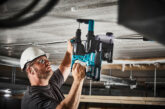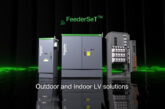
Stewart Gregory, VP of Power Products at Schneider Electric, discusses why it’s essential to keep up with new innovations as they arrive.
Innovative technologies are now used to facilitate business operations across a vast number of industries. The electrical industry is no exception. Change in the electrical industry has moved so rapidly that those who were slow to catch on are now being left behind. In the meantime, those who welcomed new innovations as they arose have benefitted in a multitude of ways.
Given the increasingly competitive and constantly progressing nature of the industry, it has never been more critical for electrical contractors to stay on top of the latest products, trends and techniques to be competitive.
Yet, as the importance of software and connectivity continues to grow, the sector is becoming increasingly divided, slowly splitting between those who recognise the opportunity and those who are yet to be convinced. For those that wait too long the chance of catching up diminishes, as the capabilities gap continues to grow.
An unprecedented number of installers and engineers will soon be retiring from the electrical industry. This provides the opportunity to upskill the sector ‘en masse’. Therefore, those in the profession, and those entering it, need the training to prepare them for the rapidly digitising workplace.
End users are digitising, and electrical engineers need to digitise along with them, otherwise companies may find themselves unable to fulfil the needs of their customers. In the residential sphere, customers are demanding smart homes whilst in corporate buildings, energy management systems. To match changing customer expectations, electrical contractors need to get trained on what these products are, the benefits, and how to install them to avoid being left behind.
The opportunities which digitisation and innovation present to the electrical industry are emerging fast. These include energy management, predictive and preventive maintenance, service contracts and reduced running costs for the client, to name but a few. Those businesses which successfully implement new technologies are set to receive a number of overarching benefits.
Gaining a competitive advantage
Working with the latest technologies can majorly improve efficiency for electrical contractors, ultimately giving them an edge in this competitive market. For example, working on boards with plug-in components, such as Isobar P, cuts the wiring time in half for the electrical contractor as well as leveraging connected technologies that allow users to instantly monitor the health and energy usage of their distribution boards, via simply connected software packages. This means the electrical contractor saves time on the installation whilst the end user saves money through greater connectivity.
Furthermore, digital advancements have brought changes to product configurators. If you’ve designed a system with different connected components, electrical contractors no longer need to spend time either speaking to a third party or looking up each product to ensure they’re all compatible.
Thanks to the digitalisation incorporated by Schneider Electric, compatibility can be quickly and simply checked – all via a mobile phone. Electrical contractors can simply download a simple App, connect to the board and check the compatibility of different components. The App will then alert them to any issues and provide a full maintenance log and traceability.
These are just two examples of the ways that digital technologies and innovation can increase efficiency for both electrical contractors and their customers. Those who fail to get trained on new digital products could find themselves working twice as hard as their competitors to achieve the same result. This enables electrical contractors to work smarter instead of harder.
Safer and simpler maintenance
Safety is a key consideration for all those in the electrical industry. Being able to automate certain tasks, or flagging issues remotely, removes many of the risks that electrical contractors face on a daily basis.
Digitisation and connectivity of the electrical system also brings its benefits for the installed base, providing visibility of the system status (loading, alarms, location) at a device level, either locally or remotely via the App, allowing for a more focused call out for emergency/preventive and predictive maintenance. This is coupled with full traceability of the product. In additional full analytics, packages may be added on top to provide dynamic monitoring of the system and recommendation, prolonging the life of the equipment and building a closer relationship with the end user.
Meeting customer demand
Customers are increasingly aware of the latest technological innovations and, therefore, expect these to be offered to them at the very least. Being digital-smart means that you can fulfil the needs of your customers and lead the way in educating them on the vast benefits associated with smart or digital devices in the electrical industry.
An electrical contractor who is limited to installing simple wired-in solutions is far from meeting the current expectations of customers. An inert device that isn’t IoT connected can’t tell a customer anything until someone physically looks at it, an unnecessary inconvenience in today’s connected world. However, one that is constantly streaming data can offer them lots of useful, actionable insights in real-time – on factors such as energy consumption, equipment health, and faults.
By offering smart innovative solutions to customers, electrical professionals can transform businesses, saving installation time, energy and money. For example, a recent study showed that for machine builders, embracing IoT could mean drastically reducing their time-to-market by up to 50% as well as reducing their maintenance costs.
Solutions which incorporate Schneider Electric’s EcoStruxure can help professionals to deliver on the expectation of IoT for their customers. EcoStruxure encompasses connected products that deliver operational data in real-time, edge control to manage the process, and optimising as needed. Apps and analytics then provide the agility to allow users to make decisions faster.
Getting up to speed
It’s not in question that digital transformation presents exciting opportunities for electrical contractors to reduce costs, save time, increase efficiency and safety. However, these don’t come without their challenges and pitfalls – especially for the less technologically savvy. As with many industries, the pace of technological advancements means swiftly changing customer expectations as well as necessitating new skills in the electrical industry.
There is a prime opportunity for the next generation of electrical professionals to carve out a place for themselves in the industry, and offer real value to their teams at the same time. Customers are looking for electrical advisors who can bring confident, individual recommendations for their specific needs, as well as digital solutions that enable superior monitoring and maintenance.
Meeting these ever-changing needs will be a prerequisite for success in the future of the electrical industry.
Visit the Schneider Electric Electrician Partner Portal by clicking here









